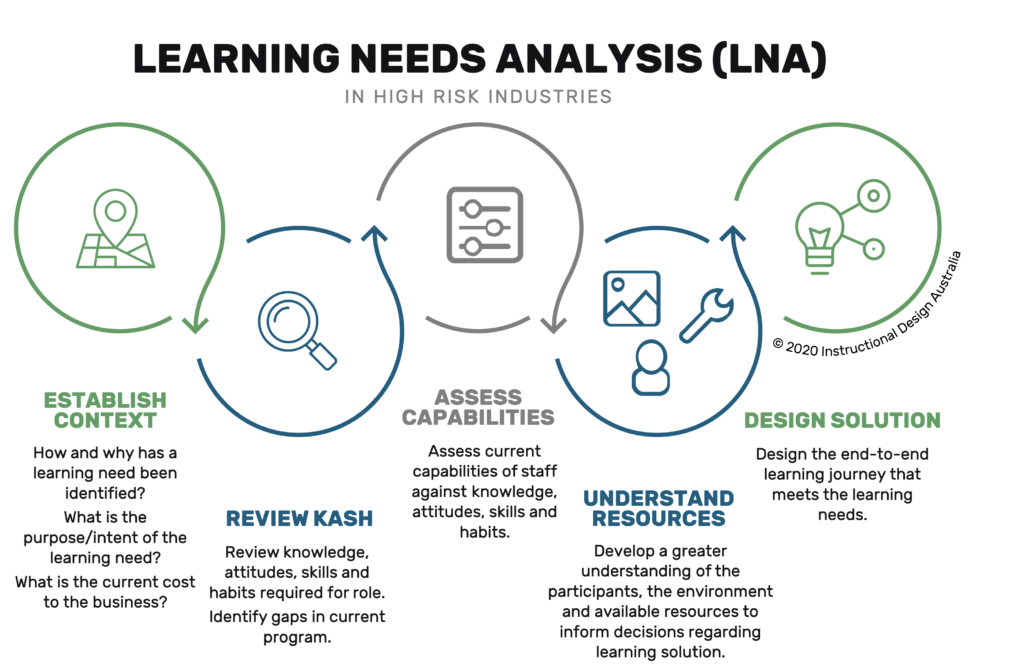Conducting a Learning Needs Analysis (LNA) in High-Risk Industries
What is a Learning Needs Analysis (LNA)?
The initial (and key!) step to effective learning design and development is determination of learning needs through a Learning Needs Analysis (LNA).
These needs may include knowledge, skills, attitudes and behaviours necessary to perform a role correctly, efficiently and safely.
The LNA is critical in determining:
- The primary cause/s of the problem, opportunity, or need
- The audience/s with capability gaps
- Areas where performance problems, opportunities or needs are caused by a lack of skills, knowledge or required behaviour
- A recommended solution (and the role learning may play)
- Learning program and performance outcomes expected by the organisation
The LNA process is particularly important in high-risk industries – such as transport, agriculture and construction – which accounted for 69% of work-related fatalities in 2018 [1].
In these high-consequence environments, a knowledge or skills gap, or poor attitudes and behaviours come at a great cost.
How does Instructional Designs Australia (IDA) conduct a Learning Needs Analysis (LNA) in high-risk industries?
1. Establish context
Establishing organisational context is crucial before considering what a potential solution may look like. This includes how and why a learning need has been identified, what the purpose/intent of the learning need is and what the current cost is to the business. In high-risk industries, the ‘cost’ may essentially be the ‘higher risk’ of health and safety incidents.
2. Develop/review skills matrix and identify gaps
It is essential that any modifications and/or additions to current training do not compromise other essential knowledge and skills.
In high-risk industries, it is important to identify essential role-based knowledge and skills prior to assessing capabilities [2]. A Risk-based Training Needs Analysis (RBTNA) can assist.
An RBTNA is used to identify and score the risks associated with workplace tasks and activities. This data is key when deciding how each risk will be minimised via learning, assessment and competency management activities.
Any gaps will determine additional learning needs to be addressed in the learning solution.
The RBTNA ensures the design of a learning architecture and programs that effectively meet both learning needs and risks.
3. Assess current capabilities
Develop an understanding of participant current capabilities for each knowledge requirement or skill described in the skills matrix/RBTNA.
Use qualitative (interview managers, supervisors and trainers) and quantitative (assessments, surveys) evidence to gather data.
Highlight knowledge and skills that are demonstrated/performed at a low standard; these will also be addressed in the learning solution.
4. Understand what you have to work with
In order to propose a learning solution, we first develop an understanding of:
- The participants, including:
- Number of participants
- Current experience
- Availability
- Location
- The environment and potential delivery methods (e.g. face-to-face, on-the-job, simulations, eLearning, blended learning)
- Available resources, including:
- Equipment, materials, tools, software etc.
- Training environments – both physical and virtual (these are highly valuable in high-consequence-industries to minimise risk [3])
- Subject Matter Experts (SMEs) to ensure accuracy and relevancy of content
5. Design a learning solution
Design a learning architecture to close identified capability gaps.
The learning architecture may include a combination of learning solutions, including facilitator-led training, on-the-job training and refresher training. In high-risk industries, our solutions incorporate competency management strategies such as refresher training and/or up skill opportunities.
Once the program has been piloted, we conduct a Post-Implementation Review (PIR) using questionnaires, focus groups and/or interviews to identify areas for improvements.
To simplify this process, we have developed Learning Needs Analysis (LNA) templates and guides.
In fact, we have a toolkit that will support you through the end-to-end process of designing, developing and evaluating your own program. Click here to find out more.
Would you prefer a skilled professional to do it for you? Contact us to discuss how we can help!
Related Articles and Blogs
- Developing and Maintaining Competency in High-Risk Environments
- Our Design Method
- Our Work
- Is Your Organisation Managing Risk?
- Changing the ‘Way We Do Things Around Here’
- Learning Needs Analysis (LNA) Templates
References
[1] Safe Work Australia (2018). Work-related Traumatic Injury Fatalities, Australia 2018. Retrieved from https://www.safeworkaustralia.gov.au/system/files/documents/2002/work_related_traumatic_injury_fatalities_report_2018.pdf
[2] WIOA Australia (2019). The Technical Competency Handbook: Knowledge, skills and competency development for water industry operations staff.
[3] Training Industry, Inc. (April 11, 2017). Training in High-Risk Industries
FAQs
How do you conduct a learning needs analysis?
Steps to conduct a learning needs analysis:
- Establish context
- Review KASH
- Assess capabilities
- Understand resources
- Design solution
What is the purpose of a learning needs analysis?
The purpose of a Learning Needs Analysis (LNA) is to determine the learning needs. These needs may include knowledge, skills, attitudes and behaviours necessary to perform a role correctly, efficiently and safely.
What are examples of learning needs?
Learning needs are knowledge, skills, attitudes and behaviours necessary to perform a role correctly, efficiently and safely. Examples include communication skills, technological skills, mindset shifts, leadership skills, performance management skills.
Why do a training needs analysis?
A training needs analysis is critical in determining:
- The primary cause/s of the problem, opportunity, or need
- The audience/s with capability gaps
- Areas where performance problems, opportunities or needs are caused by a lack of skills, knowledge or required behaviour
- A recommended solution (and the role learning may play)
- Learning program and performance outcomes expected by the organisation
Contact Instructional Design Australia
Instructional Design Australia (IDA) provides instructional design services including conducting Training Need Analysis. With team members in Melbourne, Sydney, Brisbane and Perth IDA will enable your people to engage, learn and perform.
Office
E: info@discoverlearning.com.au
Ph:1300 528 736
Michael Peart
E: michael@discoverlearning.com.au
Ph: 0434 075 231
Bianca Schimizzi
E: bianca@discoverlearning.com.au
Ph: 0416 013 623



